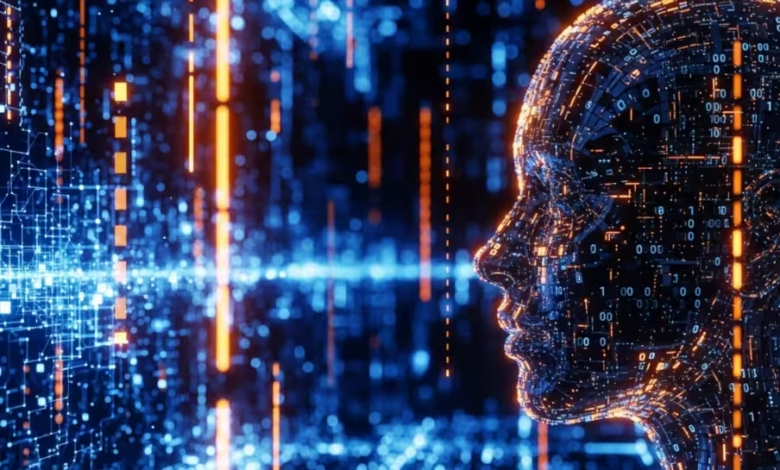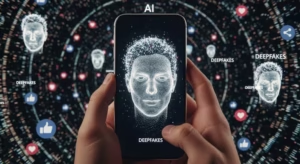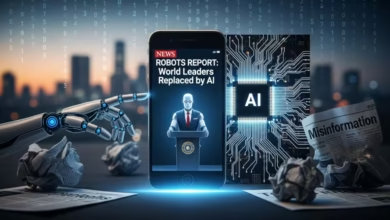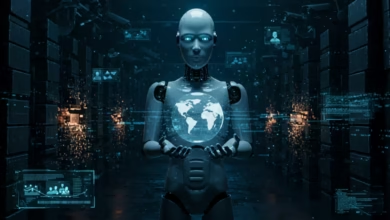AI and Deepfakes: The New Era of Digital Deception

In the blog post AI and Deepfakes: The New Era of Digital Deception, the complexities of AI and deepfakes in today’s digital landscape are explored. The piece begins with an understanding of AI and deepfakes, highlighting their significant role in creating synthetic media. It then discusses the impact of generative AI on the proliferation of these deceptions, particularly concerning misinformation and its troubling political implications. The article emphasizes the importance of recognizing these technological advancements as tools that could mislead the public. Finally, it offers actionable takeaways for individuals and organizations to effectively combat misinformation in media, fostering a more informed society. The summary encapsulates the critical conversation around AI and deepfakes, urging readers to remain vigilant in this new era of digital deception.
Understanding AI And Deepfakes In The Digital Landscape

The emergence of AI and Deepfakes marks a transformative moment in the digital landscape, raising significant ethical and technological questions. These powerful tools utilize generative AI algorithms to create hyper-realistic content that can mimic human speech, facial expressions, and even actions. While they offer creative possibilities for filmmakers and advertisers, they also pose serious risks when used maliciously, often generating misinformation that can mislead the public and undermine trust.
Key Concepts To Grasp
- Definition of Deepfakes and their basic technology
- Applications of AI in various industries
- Potential benefits and creative uses of generative AI
- Risks associated with AI and Deepfakes
- The role of ethics in AI development
- Legislation and regulatory measures being implemented
- Techniques for detecting and mitigating deepfake threats
As society grapples with the implications of AI and Deepfakes, it is crucial for stakeholders—from policymakers to technology developers—to foster a landscape where creativity and responsibility coexist. By understanding the deep technical architecture behind these tools, as well as the ramifications of their misuse, we can begin to navigate a future where digital deception is carefully managed, protecting individuals and society as a whole.
The Impact Of Generative AI In Creating Synthetic Media

Generative AI has revolutionized the way synthetic media is created, leading to a dramatic increase in both the complexity and realism of digital content. This technology enables the production of highly convincing media, including images, videos, and audio, which can closely mimic real-life scenarios. However, with these advancements come significant ethical considerations and practical challenges that society must address. The usage of AI in creating deepfakes has raised pressing concerns regarding authenticity, misinformation, and the potential for misuse in various fields, including politics, entertainment, and education.
The ability to create synthetic media has empowered creators in numerous industries. From entertainment companies that leverage deepfake technology to enhance storytelling to businesses that use AI-generated content for marketing campaigns, the potential applications are vast. Yet, the very same tools that enable creativity also pose risks, as malicious actors can employ them to fabricate misleading information that can sway public opinion or damage individual reputations. This dichotomy underscores the urgent need for effective deepfake detection methodologies to safeguard against potential threats associated with synthetic media.
Examples of Generative AI Techniques in Synthetic Media Production
| Technique | Application | Example |
|---|---|---|
| GANs (Generative Adversarial Networks) | Image Generation | Creating lifelike portraits |
| Style Transfer | Artistic Effects | Mimicking famous art styles |
| Deep Learning | Video Manipulation | Enhancing film special effects |
| Text-to-Image Synthesis | Visual Storytelling | Generating images from textual descriptions |
Steps To Identify Deepfake Content
- Analyze visual inconsistencies in the content.
- Check for unnatural facial movements or blinking patterns.
- Examine the audio quality and synchronization.
- Look for irregular lighting and shadows in the scene.
- Validate the source of the content before sharing.
- Utilize deepfake detection software if available.
- Cross-reference with known genuine sources.
While generative AI has broad implications for synthetic media, it poses unique challenges in deepfake detection. Detecting these fabricated media pieces requires sophisticated algorithms and vigilant examination. Researchers are developing innovative models to discern between authentic and altered content. However, as the technology improves, so too do the techniques used to create these deepfakes, making detection increasingly complex. This evolving landscape highlights the necessity for ongoing research and development in deepfake detection techniques to ensure the integrity of digital media.
Challenges In Deepfake Detection
The challenges in detecting deepfakes are numerous and growing. One major issue is the constantly evolving nature of generative AI techniques, which continuously improve the quality of synthetic media, making detection more difficult. Additionally, the sheer volume of media content available online further complicates effective monitoring and identification efforts. Moreover, there exists a lack of standardized protocols for identifying deepfakes, leading to discrepancies in detection capabilities and responses across various organizations and platforms. To effectively combat these challenges, a collaborative effort among tech companies, researchers, and policymakers is essential.
Navigating AI Misinformation And Its Political Implications

The rise of AI and deepfakes has transformed the digital landscape, complicating the ways in which information is shared and consumed. As technology advances, the potential for misuse also escalates, particularly in the realm of AI misinformation. This reality poses significant challenges, especially in the arena of AI and politics, where misleading information can alter perceptions and swaying public opinion. The dangers associated with deepfakes not only threaten individual reputations but can also disrupt democratic processes.
Political implications of AI-driven misinformation go beyond mere fabrication; they can lead to erosion of trust in institutions and the media. During election cycles, for example, synthetic videos can be weaponized against candidates, influencing voters through false narratives. As manipulation becomes more sophisticated, it becomes increasingly difficult for citizens to discern fact from fiction. Thus, combating this wave of AI misinformation is crucial for maintaining a healthy democratic society.
AI And Politics: A Complex Relationship
The intersection of AI and politics is marked by both opportunities and risks. On one hand, the use of AI can drive innovations in political campaigning, voter outreach, and policy making. Conversely, it also presents the risk of misinformation campaigns that can undermine the political landscape. Algorithms that govern online content can create echo chambers, further polarizing political viewpoints and making it easier for deepfake content to thrive. Understanding this complex relationship is pivotal in addressing the challenges posed by AI-driven deception.
Recommendations For Addressing AI Misinformation
- Enhance digital literacy programs to help individuals recognize misinformation.
- Implement stricter regulations on the creation and distribution of deepfake technology.
- Encourage collaboration between tech companies and governments to develop detection tools.
- Promote transparency in AI-generated content to help users identify potential misinformation.
- Support initiatives aimed at fact-checking and verifying online information.
- Engage in public awareness campaigns about the implications of AI misinformation.
- Invest in research focused on the socio-political effects of AI in media.
To navigate the complexities of AI and deepfakes, a multifaceted approach is required, addressing both technological and societal dimensions. The political implications of AI misinformation are severe, but with collective efforts, it is possible to mitigate the risks and foster a more informed populace. By taking actionable steps, we can work towards a political environment that values truth and accountability, minimizing the detrimental effects of AI-driven deception.
Actionable Takeaways To Combat Misinformation In Media
As misinformation proliferates in the digital age, combating its impact becomes crucial. AI and deepfakes are at forefront of this challenge, enabling the creation of highly convincing yet false narratives that can mislead the public. Understanding how to address these technologies is essential for both consumers and content creators. By increasing our awareness and employing effective strategies, we can reduce the risk of falling victim to these deceptions.
Steps To Prevent AI Exposure
- Stay informed about the latest developments in AI technology.
- Verify information through multiple reputable sources before sharing.
- Use technology tools designed to detect deepfakes and manipulated content.
- Encourage media literacy within your circles to foster critical thinking.
- Support and promote platforms that prioritize authentic content.
- Report false information to social media sites and web administrators.
Additionally, fostering an environment of healthy skepticism can empower individuals to critically evaluate the veracity of the content they consume. As we navigate through the complexities of AI and deepfakes, employing these steps can serve as a practical guide to safeguard ourselves and our communities from digital misinformation.
For similar articles, please visit: AI in Security & Cybersecurity
Homepage / humanaifuture.com




